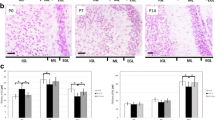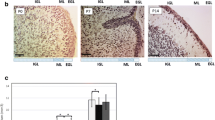Abstract
The thyroid functions of breastfed infants, as well as (indirectly) the development of their central nervous system, are dependent on the iodine status of the lactating mother. Purkinje cell protein-2 is a cell-specific marker of the cerebellum Purkinje cell and is a suitable indicator for observing the postnatal development of the cerebellum after birth. We measured the Purkinje cell protein-2 mRNA and protein levels in the rat cerebellum in the critical postnatal (14 days after birth) and maturation periods (28 days after birth) to determine the effect of different nutritional iodine levels on cerebellum growth in the offspring during lactation. We found that severe iodine deficiency resulted in thyroid dysfunction in lactating rats and their offspring on both 14 and 28 days, showing maternal total T4 16.7 ± 12.0 vs 36.4 ± 15.0, P < 0.05 (14 days) and 22.6 ± 18.7 vs 53.4 ± 9.4, P < 0.01 (28 days), and neonatal total T4 10.6 ± 2.3 vs 16.4 ± 4.7, P < 0.01(14 days) and 12.8 ± 2.9 vs 16.7 ± 3.4, P < 0.05 (28 days), respectively. The Purkinje cell protein-2 mRNA and its protein levels in offspring rats were significantly reduced that showed Purkinje cell protein-2 mRNA 1.12 ± 0.04 vs 2.25 ± 0.53, P < 0.05 (14 days) and 1.74 ± 0.94 vs 8.69 ± 2.71, P < 0.01 (28 days). However, mild iodine deficiency and excessive iodine maintained almost normal thyroid function in maternal and neonatal rats and normal Purkinje cell protein-2 mRNA and protein levels in offspring’s cerebellum. We conclude that severe iodine deficiency could significantly reduce Purkinje cell protein-2 mRNA and its protein levels, indicating that the cerebellum development was retarded, but mild iodine deficiency and excessive iodine could maintain them at an approximately normal level by the mother’s and offspring’s compensations, especially by the mother’s mammary glands.





Similar content being viewed by others
References
Burgi H (2010) Iodine excess. Best Pract Res Clin Endocrinol Metab 24:107–115
Laurberg P, Cerqueira C, Ovesen L et al (2010) Iodine intake as a determinant of thyroid disorders in populations. Best Pract Res Clin Endocrinol Metab 24:13–27
Verheesen RH, Schweitzer CM (2008) Iodine deficiency, more than cretinism and goiter. Med Hypotheses 71:645–648
Chen ZP, Hetzel BS (2010) Cretinism revisited. Best Pract Res Clin Endocrinol Metab 24:39–50
Zimmermann MB (2009) Iodine deficiency. Endocr Rev 30:376–408
Azizi F, Smyth P (2009) Breastfeeding and maternal and infant iodine nutrition. Clin Endocrinol (Oxf) 70:803–809
Wang Y, Zhang Z, Ge P et al (2009) Iodine status and thyroid function of pregnant, lactating women and infants (0–1 year) residing in areas with an effective universal salt iodization program. Asia Pac J Clin Nutr 18:34–40
Yan YQ, Chen ZP, Yang XM et al (2005) Attention to the hiding iodine deficiency in pregnant and lactating women after universal salt iodization: a multi-community study in China. J Endocrinol Invest 28:547–553
Berbel P, Obregon MJ, Bernal J et al (2007) Iodine supplementation during pregnancy: a public health challenge. Trends Endocrinol Metab 18:338–343
Dorea JG (2002) Iodine nutrition and breast feeding. J Trace Elem Med Biol 16:207–220
Ares S, Quero J, Morreale de Escobar G (2005) Neonatal iodine deficiency: clinical aspects. J Pediatr Endocrinol Metab 18(Suppl 1):1257–1264
Zimmermann MB (2007) The impact of iodised salt or iodine supplements on iodine status during pregnancy, lactation and infancy. Public Health Nutr 10:1584–1595
Vandaele S, Nordquist DT, Feddersen RM et al (1991) Purkinje cell protein-2 regulatory regions and transgene expression in cerebellar compartments. Genes Dev 5:1136–1148
Jooste PL, Strydom E (2010) Methods for determination of iodine in urine and salt. Best Pract Res Clin Endocrinol Metab 24:77–88
Ramakers C, Ruijter JM, Deprez RH et al (2003) Assumption-free analysis of quantitative real-time polymerase chain reaction (PCR) data. Neurosci Lett 339:62–66
Wang K, Sun YN, Liu JY et al (2006) Type 1 iodothyronine deiodinase activity and mRNA expression in rat thyroid tissue with different iodine intakes. Chin Med J (Engl) 119:1899–1903
Wang K, Sun YN, Liu JY et al (2009) The impact of iodine excess on thyroid hormone biosynthesis and metabolism in rats. Biol Trace Elem Res 130:72–85
Chan S, Kilby MD (2000) Thyroid hormone and central nervous system development. J Endocrinol 165:1–8
Berbel P, Navarro D, Auso E et al (2010) Role of late maternal thyroid hormones in cerebral cortex development: an experimental model for human prematurity. Cereb Cortex 20:1462–1475
Martinez-Galan JR, Escobar del Rey F, Morreale de Escobar G et al (2004) Hypothyroidism alters the development of radial glial cells in the term fetal and postnatal neocortex of the rat. Brain Res Dev Brain Res 153:109–114
Koibuchi N (2008) The role of thyroid hormone on cerebellar development. Cerebellum 7:530–533
Williams GR (2008) Neurodevelopmental and neurophysiological actions of thyroid hormone. J Neuroendocrinol 20:784–794
Koibuchi N, Chin WW (2000) Thyroid hormone action and brain development. Trends Endocrinol Metab 11:123–128
Obregon MJ, Calvo RM, Del Rey FE et al (2007) Ontogenesis of thyroid function and interactions with maternal function. Endocr Dev 10:86–98
Redd KJ, Oberdick J, McCoy J et al (2002) Association and colocalization of G protein alpha subunits and Purkinje cell protein 2 (Pcp2) in mammalian cerebellum. J Neurosci Res 70:631–637
Serinagaoglu Y, Zhang R, Zhang Y et al (2007) A promoter element with enhancer properties, and the orphan nuclear receptor RORalpha, are required for Purkinje cell-specific expression of a Gi/o modulator. Mol Cell Neurosci 34:324–342
Sulaiman P, Fina M, Feddersen R et al (2010) Ret-PCP2 colocalizes with protein kinase C in a subset of primate ON cone bipolar cells. J Comp Neurol 518:1098–1112
Bansal R, Zoeller RT (2008) Polychlorinated biphenyls (Aroclor 1254) do not uniformly produce agonist actions on thyroid hormone responses in the developing rat brain. Endocrinology 149:4001–4008
Guan J, Luo Y, Denker BM (2005) Purkinje cell protein-2 (Pcp2) stimulates differentiation in PC12 cells by Gbetagamma-mediated activation of Ras and p38 MAPK. Biochem J 392:389–397
Simons MJ, Pellionisz AJ (2006) Genomics, morphogenesis and biophysics: triangulation of Purkinje cell development. Cerebellum 5:27–35
Zou L, Hagen SG, Strait KA et al (1994) Identification of thyroid hormone response elements in rodent Pcp-2, a developmentally regulated gene of cerebellar Purkinje cells. J Biol Chem 269:13346–13352
Manzano J, Morte B, Scanlan TS et al (2003) Differential effects of triiodothyronine and the thyroid hormone receptor beta-specific agonist GC-1 on thyroid hormone target genes in the brain. Endocrinology 144:5480–5487
Anderson GW, Hagen SG, Larson RJ et al (1997) Purkinje cell protein-2 cis-elements mediate repression of T3-dependent transcriptional activation. Mol Cell Endocrinol 131:79–87
Anderson GW, Larson RJ, Oas DR et al (1998) Chicken ovalbumin upstream promoter-transcription factor (COUP-TF) modulates expression of the Purkinje cell protein-2 gene. A potential role for COUP-TF in repressing premature thyroid hormone action in the developing brain. J Biol Chem 273:16391–16399
Funding
This work was supported by grants from the National Nature Science Foundation of China (No. 30671816). The authors declare that there are no conflicts of interest that would prejudice the impartiality of this scientific work.
Author information
Authors and Affiliations
Corresponding author
Rights and permissions
About this article
Cite this article
Zhang, L., Sun, Y.N., Li, Y.M. et al. Effect of Different Iodine Nutrition on Cerebellum Pcp-2 in Rat Offspring During Lactation. Biol Trace Elem Res 143, 1629–1639 (2011). https://doi.org/10.1007/s12011-011-8991-3
Received:
Accepted:
Published:
Issue Date:
DOI: https://doi.org/10.1007/s12011-011-8991-3




